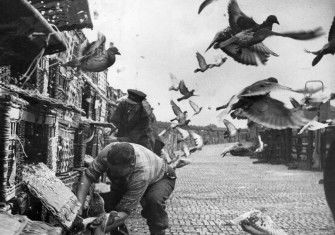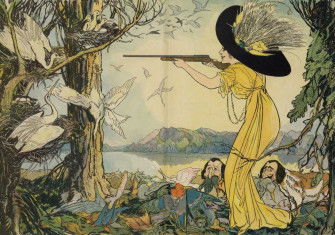‘Birds in the Ancient World’ by Jeremy Mynott review
Birds in the Ancient World: Winged Words by Jeremy Mynott explores the role birds played in intellectual, practical, and emotional lives.
 Pity the wryneck – a species of long-tongued woodpecker – in ancient Greece: it had the great misfortune to be considered an essential part of a sex toy. The poor bird was spread-eagled and bound to the four spokes of a wheel, which, when spun, whistled in a way thought sure to arouse desire in its recipient. We remember its fate today when we jinx people: the word jinx being derived from its Greek name, iunx.
Pity the wryneck – a species of long-tongued woodpecker – in ancient Greece: it had the great misfortune to be considered an essential part of a sex toy. The poor bird was spread-eagled and bound to the four spokes of a wheel, which, when spun, whistled in a way thought sure to arouse desire in its recipient. We remember its fate today when we jinx people: the word jinx being derived from its Greek name, iunx.
Pity, too, the pigeon squab on a Roman farm, force fed two or three times a day and confined to a caged nest with its legs broken to ensure it couldn’t be – as one contemporary vividly put it – liberated ‘from the slavery of fat’.
But if such lesser cruelties seem to carry echoes of the greater ones in the Roman arena, they are far from defining the role birds played in the lives – intellectual, practical, emotional and otherwise – of men and women in the classical world. As Jeremy Mynott shows in this superb book, birds were everywhere: on the table, of course, but also in houses, both as pets and as co-habitants in nests under the eaves; in medicine and magic; in sports and entertainments; in marking time, in military planning, in communication.
This ubiquity is in part a function of classical societies being infinitely more rus than urbe; Mynott quotes Robin Osborne’s point that: ‘The Greek city was not a town and its territory … it was a variously peopled landscape.’ He might have added that the landscape was variously – prodigiously – birded, too. Even urban spaces were home to scavengers such as kites and corvids; to cuckoos and hoopoes; to owls, swallows and swifts; and to stranger visitors, such as the ibis.
This gave both a depth of familiarity and an intimacy to the relationship that historians have to work at to recapture. Aristophanes mentions perhaps 75 species of bird in his works; some 69 can be identified in the surviving wall paintings of Pompeii, Herculaneum and elsewhere. For such abundant specificity in art to be meaningful, it must speak to a detailed and shared understanding of the characters and behaviour of the birds themselves, not merely their physical traits.
This is borne out by, among other things, the frequency with which birds seem to have appeared in people’s dreams. Artemidorous, a writer and analyst of the second century ad, has left us 95 case studies of his patients, who dreamt of numerous species, from eagles and vultures, to cormorants, kites and storks. The spurious meanings he reads into them – ‘A raven represents an adulterer and a thief’, for example – are less interesting than the fact they find such lodging in the classical psyche.
The idea that birds signified something in someone’s subconscious is not, in context, far-fetched. Nor is the step to thinking their appearance in a dream might cause something to happen a large one. After all, birds weren’t merely a physical presence in the ancient world, they were a metaphysical presence, too; there is a reason that the Greek word for bird, ornis, was also the word for omen.
Simple observation demonstrated that the arrival of the swallow signalled the beginning of spring, for example. Indeed, so close was the identification here that the swallow (chelidon) gave its name to both the spring wind (chelidonia) on which it arrived and the greater celandine (chelidonion) that blossomed alongside. But did the swallow come with spring, or did the swallow bring it? The line between empirical observation, which the Greeks invented, and speculative observation is less clear than we think.
Mynott quotes, sometimes at length, from 120 authors in total, some translated into English for the first time. All the translations are Mynott’s own. The period covered is approximately 700 BC to AD 300 and, since Mynott’s approach is thematic, each chapter ranges pretty freely across those thousand years. It is, without doubt, a major achievement and a brilliantly sustained exercise in what Mynott, paraphrasing Claude Lévi-Strauss, calls ‘thinking with birds’.
As birds were intermediaries between the gods and mankind, so they are Mynott’s intermediaries between the ancient world and ours. He uses them to illuminate classical civilisation’s sense of the world and humanity’s place in it. But in so doing, he encourages us to think more profoundly about our own, often unreflective relationship with nature and, in particular, how the development of modernity has depredated habitats and vastly diminished bird populations.
He is alert, too, to the extent to which rational and magical thinking can and do co-exist. We might agree with Cicero that bird augury left scope for ‘a little error, a little superstition, and a great deal of fraud’; but we should caution against dismissing such practices as mere expressions of irrationality. We should see them not as ‘mistaken forms of explanation about how the world works but as modes of dealing with it’.
He also encourages us to think about the ways in which experience of the world and understanding of it are inextricably linked. What does it mean to say the classical world was an aural – and oral – one? We may not know how it sounded – Mynott cites the musicologist Christopher Page’s observation that we might be less inclined to think of the ancient Greeks as the fathers of western rationalism if we could actually hear the music they admired – but those sounds would anyway mean something different to us. The case of the poor wryneck on its wheel is but one example. The heard world, no less than aesthetics or rationality, is a social construct; other ways of thinking – with or without birds – are never far away.
We are fortunate to have in Mynott, who is both an ornithologist and a classicist, the perfect guide for such explorations. The Greeks had a phrase for such luck: we are under good birds, they would say.
- Birds in the Ancient World: Winged Words
Jeremy Mynott
Oxford 480pp £30
Mathew Lyons is the author of The Favourite: Ralegh and His Queen (Constable, 2012).






![‘Scientific Researches! New Discoveries in Pneumaticks! [sic] or an Experimental Lecture on the Powers of Air, May 23, 1802’, by James Gillray. Minneapolis Institute of Art. Public Domain.](/sites/default/files/styles/teaser_list/public/2025-03/lecture_history_today_0.jpg?itok=mHN_obPV)